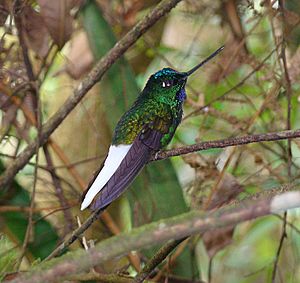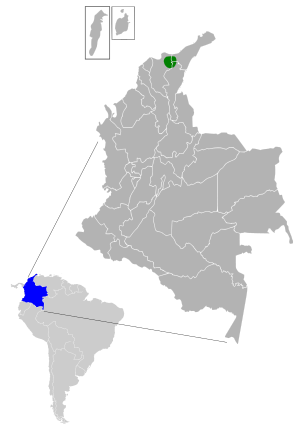White-tailed starfrontlet facts for kids
Quick facts for kids White-tailed starfrontlet |
|
|---|---|
 |
|
| Conservation status | |
| Scientific classification | |
| Genus: |
Coeligena
|
| Species: |
phalerata
|
 |
|
| Synonyms | |
|
Leucuria phalerata |
|
The white-tailed starfrontlet (Coeligena phalerata) is a beautiful type of hummingbird. It lives only in the Sierra Nevada de Santa Marta mountains in northeastern Colombia. This special bird is known for its bright colors and, of course, its white tail!
Contents
About Its Name
The white-tailed starfrontlet is a kind of hummingbird. Scientists group it with other similar hummingbirds in a family called Coeligena. This bird is the only one of its exact kind, meaning it doesn't have different subspecies.
What It Looks Like
The white-tailed starfrontlet is about 14 cm (5.5 inches) long. Both male and female birds have a long, straight, black beak. The female's beak is a bit longer than the male's. Both also have a white spot behind each eye. They both have a forked tail, but the male's tail is more deeply split.
Male Birds
Adult male white-tailed starfrontlets have shiny dark green feathers on their upper body. They have a bright, sparkling turquoise cap on their head. Their entire tail is white. They also have a blue patch on their throat, called a gorget. Their belly is mostly emerald green. They have fluffy white feathers on their legs and white feathers under their tail.
Female Birds
Adult female birds have a duller blue-green cap and shiny green feathers on their upper body. Their tail is a bronzy color with light brown tips. Their belly is a reddish-brown color. Young birds look a lot like the adult females.
Where It Lives
The white-tailed starfrontlet is found only in the isolated Sierra Nevada de Santa Marta mountains in northeast Colombia. It lives in humid, wet mountain forests. Male birds often prefer open spaces inside the forest. Female birds are more often seen at the edge of the forest. These birds live at high elevations, from about 1,400 to 3,700 meters (4,600 to 12,100 feet) above sea level.
How It Behaves
Movement
Scientists don't know much about how the white-tailed starfrontlet moves around. It's not known if they travel to different areas during the year.
Feeding
The white-tailed starfrontlet eats nectar from flowers. It is known to feed from Fuchsia flowers and bromeliad plants. It likely drinks nectar from many other types of plants too, just like other hummingbirds in its family. This bird is more protective of its feeding areas than some other Coeligena hummingbirds. It also sometimes feeds by flying a regular path between flowers, which is called trap-lining. Besides nectar, it also catches small insects and spiders. It finds them by picking them off leaves or by catching them in the air.
Reproduction
The breeding season for the white-tailed starfrontlet seems to be from February to April. However, not much else is known about how they raise their young.
Vocalization
Only a few sounds made by the white-tailed starfrontlet have been recorded. It makes a high-pitched chattering sound like "tsee-tsee-tsi-tsi-tsirrrrr." It also makes lower-pitched short rattling sounds.
Status
The IUCN (International Union for Conservation of Nature) first said the white-tailed starfrontlet was of "Least Concern." But since 2018, they have changed its status to "Near Threatened." This means it could become endangered in the future. The bird lives in a very small area. Its home is being lost and broken up into smaller pieces. This is a big threat to the birds. Scientists don't know exactly how many white-tailed starfrontlets there are, but they believe the number is going down.
See also
 In Spanish: Inca coliblanco para niños
In Spanish: Inca coliblanco para niños


